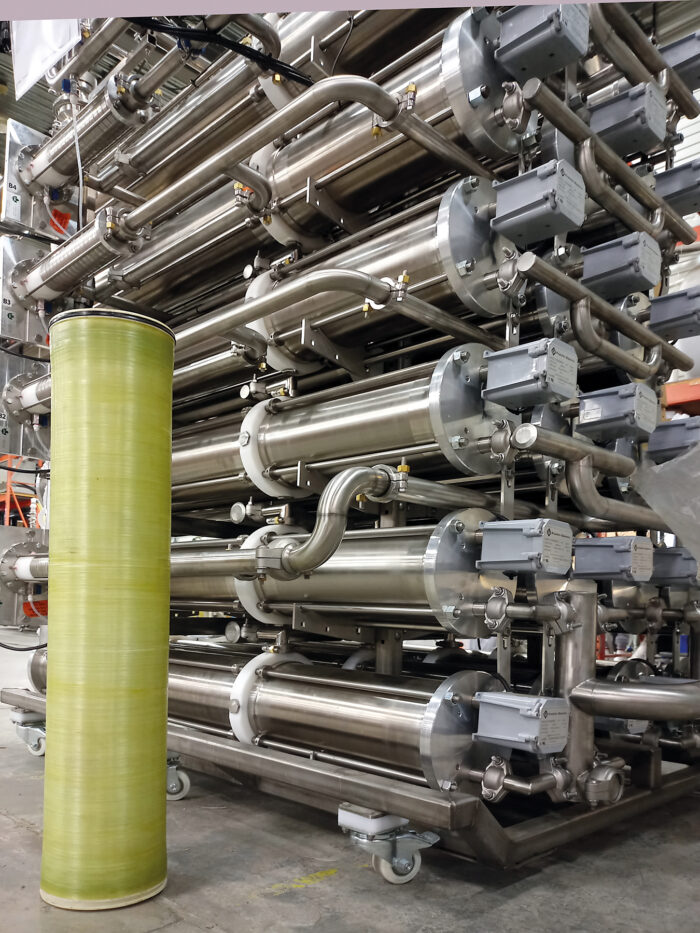Maintaining your RO and managing its membranes properly
It’s crucial to carefully maintain your RO and properly manage its membranes to keep your equipment running at its best. Doing so not only extends the life of the equipment, but also helps to keep it clean, sterile, and in good working order. Keeping the RO in good condition also gives it better yield and is more cost efficient in the long term.
Choosing and maintaining pre-filtering cartridges
Properly choosing and maintaining your pre-filtering cartridges for your RO is a key step in the concentration process. For all types of ROs, we recommend CDL’s 5-micron cartridges, which are excellent at filtering undesirable particles. It’s important to replace the cartridges regularly to make sure the pre-filter continues to work properly. It’s also a good idea to have a specific pre-filtering cartridge for membrane washing to prevent the soap from cross contaminating the sap. There are pre-filtering cartridges for all types of ROs, from the 9 7/8” model for the Nano RO to the 20” for the Fendeuse and HeRO! For higher capacity ROs like the HeRO, multi cartridges (with five 20” cartridges) are a good choice.
Membrane models and precautions
CDL offers different membrane sizes for each of its ROs, including 4” membranes for the Nano and Hobby ROs, 8”membranes for the Fendeuse and HeRO, without forgetting the 16” membranes. Before using a new membrane, it’s important to soak it for at least 24 hours. Doing so helps maximize its efficiency when you start concentrating. Always pay close attention to the moisture level of the membranes and keep them from frosting over to ensure they remain structurally sound. It’s also critical to never leave a membrane soaking in sugar water when the RO isn’t in use. This will quickly and significantly damage the membranes. As soon as concentration is complete, the RO needs to be desugared and rinsed.
The importance of regular maintenance
Several factors influence membrane performance. The operating pressure, sap temperature, ionic strength (sugar concentration), membrane porosity, membrane condition, sap quality, bacterial load, pH, recirculation system efficiency, and pre-filtration quality all have an impact! That’s why regular membrane maintenance is essential to keeping your system running properly all season long. Washing prevents bacterial growth, prevents the membrane pores from clogging, and even extends the membranes’ lifespan.
Washing instructions for top performance
You will need to wash your membranes with different substances, like alkaline soap, citric acid, and peracetic acid (at the end of the season) to make sure they keep performing properly.
1 – Alkaline soap wash
The first step in a membrane wash should always be an alkaline soap wash. Available as a liquid or powder, with conventional and organic options, alkaline soap opens the membrane pores and removes biofilm and organic matter deposits. Membrane manufacturers recommend daily washes to prevent potential damage from excessive dirt. For best results, you can combine or alternate different types of soap, depending on the type of clogging. The solution should be the same colour at the start and end of the soap wash; otherwise, the membrane will need to be drained, rinsed briefly, and washed again. The easiest way to determine how much soap to use is to check the pH of the wash tank. Depending on the membrane, the pH of the solution should be between 9 and 12.
2 – Citric acid wash
When washing with alkaline soap isn’t enough, citric acid is the second step. Citric acid washing should only be carried out after maximizing the effectiveness of alkaline washes, as indicated by a clear solution in the wash tank during the last wash. You need 250 ml of citric acid per membrane for this step, and the washing temperature has to reach 43 °C for maximum efficiency. Membranes can be soaked in citric acid for a few days, but it’s recommended to circulate the liquid occasionally (by starting the RO for a few minutes and leaving them to soak) for greater efficiency. Since citric acid closes the membrane pores, the acid wash should be followed by a rinse, then an alkaline wash and a final rinse. This is necessary to preserve the integrity of the membranes and maintain their performance.
3 – Peracetic acid wash
If alkaline soap and citric acid aren’t enough, you can also use peracetic acid. It’s a sterilizing treatment that’s typically used at the end of the season, but it’s a good idea to use it regularly to prevent bacteria from growing on the membrane. Peracetic acid also kills bacteria, and is used when soap and acid are no longer working and the membranes aren’t performing at their best. For this wash, you need to add 700 ml per 100 litres (1 oz per gallon) of the RO’s dead volume. The solution must not exceed 25 °C. Membranes should be soaked in the solution for 1 to 12 hours, depending on how clogged they are. It’s vital to follow the instructions carefully, because peracetic acid can cause irreversible damage if used incorrectly.
Cleaning and storing membranes at the end of the season
At the end of the season, it’s important to give the membranes a final wash with soap followed by a thorough rinse. Completely drain the RO and posts, then store the membrane in a canister with a sodium metabisulfite solution, which prevents bacterial growth. It’s a good idea to check the condition of the membrane periodically and replace the preservative solution every six months. You can also store the membranes in a citric acid solution right in the RO posts. For users of the Nano RO, an even simpler solution is available: once you’ve finished your last wash, let the membranes drain, then put them in an airtight bag and freeze them.
Keep an eye on your RO all season long. If you notice any unusual noises or abnormalities, don’t wait until the next season to check it! Proactive maintenance and repair are crucial to keeping your production running smoothly.



